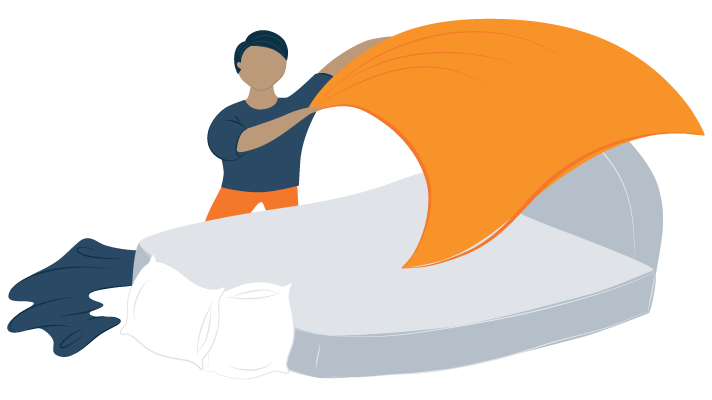Do you ever feel like your sheets are the bedding equivalent of a 5-year old? As in, they just won’t stay still? If that’s the case, now is the perfect time to find out how to keep your sheets on the bed and secure them for good.
Thankfully, this is a solvable problem, and with our helpful guide, you’ll save hours on Google searches. We’ll walk you through eight convenient ways to keep your bed linens secure so that you can spend your time worrying about more important things— like your actual 5-year old.
One Size Does Not Fit All
When you shop for sheets, an important thing to look for is how deep the sheet pockets are that go over the corners of your mattress. Sheet pockets come in three sizes: standard, deep, and extra-deep. How thick your mattress is will determine how deep your pockets should be.
If you don’t know how thick your mattress is, get out some measuring tape to determine your bed’s dimensions. Standard pockets cover a thickness between 7-14 inches, deep is anything over 14 inches and covers between 11-17 inches, and extra-deep is over 15 inches and covers between 15-22 inches.
View Our Guide: Best Deep Pocket Sheets
8 Ways to Keep Bed Sheets Tight
In this article, we’ll cover the eight best ways to keep bed sheets from slipping.
Use an Under-Sheet Beneath Fitted Sheet
Bedding might slide around because of a lack of friction, especially with softer materials like Egyptian cotton or silk. To combat this, you can place a rougher textured under-sheet beneath the fitted sheet. The added friction should increase friction, keeping your bed linens from slipping off.
The more heat you have, the higher friction increases, so look for warmer linens like Flannel or Fleece. However, if you have sensitive skin or are prone to overheating, you could try a different option below.
Try Putting the Top Corners on First
Another trick to help keep your covers in place is to put the top corners on first when you make your bed. Start by heading to the top of your bed and tuck the cover onto both top corners of your mattress. Then, move to the bottom corners.
The top corners are usually the hardest to stretch your covers over, so once that’s done, it should be easier for you to reach the bottom bed corners and pull the mattress down snug.
Use Rug Corners
You can also utilize rug corners to keep your bedding in place. Rug corners are grips placed underneath a rug’s four corners to prevent movement. You could find these handy non-slip rug corners from a hardware store, and choose some that can be used on any type of surface. Place these under your linens at each corner for a secure fit.
The goal is that they’ll have the same effect on a bed that they would on a rug and keep your linens pulled tight.
Use Sheet Suspenders
Just like their pants equivalent, these suspenders are aimed at holding your bed covers firmly in place. You’ll take the suspenders and clip them onto your sheets and secure them to the mattress, box spring, or slats. Once in place, these should keep your sheets secure.
If you desire even more security for your covers, you can buy suspenders that criss-cross underneath and will secure them even tighter.
Try Stretchy Bands
Stretchy bands are another useful tip to help keep your linens free from movement. If you’ve never used these before and images of giant rubber bands come to mind, that’s essentially what they are. Depending on the type you buy, you may have one with locking mechanisms on it or a simple band that you would wrap over the sheet to hold it in place.
Attach Safety Pins
If you still can’t keep your linens from slipping and sliding, consider pinning them down instead. Safety pins can come in handy for plenty of everyday items, including keeping sheets on the bed.
If you use this method, it’s important to pin them correctly. It’s wise to pin them with the pressure of the sheet that’s being tugged, and not against it, so that you avoid bending or weakening the pin.
Zip the Sheets
A zippered sheet set is also worth a try if you’re still having no luck; this style of bedding is highly regarded when it comes to keeping things in place, especially for kids’ beds. This type of cover features a zippered top and base that wraps around your mattress and should hold everything in place securely. These are also considered a popular choice for folks who want to make changing their linens easier.
Frequently Asked Questions
Which type of sheets do not slip as much?
If you’re in the market for new bed sheets, you may consider eliminating the issue at the source: the item itself. If you’re consistently dealing with linens that fall over, this would be an excellent opportunity to try a new material that won’t slip— or slip as much.
As mentioned earlier, Fleece or Flannel produces more warmth and would be less inclined to move about. This material is especially great if you live in a cooler climate.
Although very comfy, Satin, Bamboo, and Silk tend to be more slippery. Linen or cotton sheets would be great alternatives to purchase instead.
Conclusion
Keeping your sheets in place is an easy issue to tackle with the help of these 8 tips. What’s even more reassuring is that these solutions are inexpensive and DIY, so you don’t have to break the bank or wait on anyone else to get the job done.
If you’re not sure why your sheets won’t stay put, make sure they’re the right fit for your mattress by properly measuring your bed and buying products designed for that mattress’s size. This can also be a great excuse to mix things up and buy new bedsheets. No matter the method, getting your sheets to fit well has never been easier.
Jill Zwarensteyn
Editor
About Author
Jill Zwarensteyn is the Editor for Sleep Advisor and a Certified Sleep Science Coach. She is enthusiastic about providing helpful and engaging information on all things sleep and wellness.
Combination Sleeper

